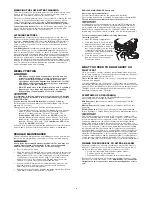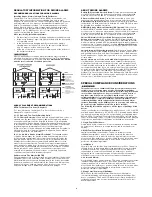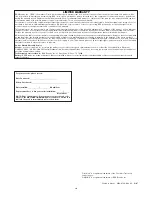
TABLE OF CONTENTS
Introduction . . . . . . . . . . . . . . . . . . . . . . . . . . . . . . . . . . . . . . . . . . . . . .1-2
Wireless Operation . . . . . . . . . . . . . . . . . . . . . . . . . . . . . . . . . . . . . .1
Fire Safety Tips . . . . . . . . . . . . . . . . . . . . . . . . . . . . . . . . . . . . . . . . .2
Basic Safety Information . . . . . . . . . . . . . . . . . . . . . . . . . . . . . . . . .2
Step By Step Guide to Programming This Alarm . . . . . . . . . . . . . . . .2
Adding and Linking Additional ONELINK
®
Alarms . . . . . . . . . . . . .2
What You Will See and Hear With This Alarm . . . . . . . . . . . . . . . . .2
Installation . . . . . . . . . . . . . . . . . . . . . . . . . . . . . . . . . . . . . . . . . . . . . . .3-4
Where to Install This Alarm . . . . . . . . . . . . . . . . . . . . . . . . . . . . . . .3
Where This Alarm Should NOT Be Installed . . . . . . . . . . . . . . . . . .3
How to Install This Alarm . . . . . . . . . . . . . . . . . . . . . . . . . . . . . . . . .4
Optional Locking Features . . . . . . . . . . . . . . . . . . . . . . . . . . . . . . . . . . .4
If Your Smoke/CO Alarm Sounds . . . . . . . . . . . . . . . . . . . . . . . . . . . .5-6
What To Do First–Identify The Type Of Alarm Signal . . . . . . . . . . .5
If the CO Alarm Sounds . . . . . . . . . . . . . . . . . . . . . . . . . . . . . . . . . .5
If the Smoke Alarm Sounds . . . . . . . . . . . . . . . . . . . . . . . . . . . . . . .5
Using the Silence Features . . . . . . . . . . . . . . . . . . . . . . . . . . . . . .5-6
Latching Features . . . . . . . . . . . . . . . . . . . . . . . . . . . . . . . . . . . . . . .6
Weekly Testing . . . . . . . . . . . . . . . . . . . . . . . . . . . . . . . . . . . . . . . . . . . . .6
Regular Maintenance . . . . . . . . . . . . . . . . . . . . . . . . . . . . . . . . . . . . . . .6
What You Need To Know About CO . . . . . . . . . . . . . . . . . . . . . . . . . .6-7
What is CO? . . . . . . . . . . . . . . . . . . . . . . . . . . . . . . . . . . . . . . . . . . .6
Symptoms of CO Poisoning . . . . . . . . . . . . . . . . . . . . . . . . . . . . . .6
Finding the Source of CO After an Alarm . . . . . . . . . . . . . . . . . . . .6
Potential Sources of CO in the Home . . . . . . . . . . . . . . . . . . . . . . .7
How Can I Protect My Family From CO Poisoning? . . . . . . . . . . . . . .7
Regulatory Information For Smoke/CO Alarms . . . . . . . . . . . . . . . .7-8
Regulatory Information for CO Alarms . . . . . . . . . . . . . . . . . . . . . . .7
Regulatory Information for Smoke Alarms . . . . . . . . . . . . . . . . . . . .8
Recommended Locations for Smoke Alarms . . . . . . . . . . . . . . . . .8
About Smoke Alarms . . . . . . . . . . . . . . . . . . . . . . . . . . . . . . . . . . . .8
Special Compliance Considerations . . . . . . . . . . . . . . . . . . . . . . . . . . .8
General Limitations Of Smoke/CO Alarms . . . . . . . . . . . . . . . . . . . . . .9
Troubleshooting Guide . . . . . . . . . . . . . . . . . . . . . . . . . . . . . . . . . . . . . .9
Limited Warranty . . . . . . . . . . . . . . . . . . . . . . . . . . . . . . . . . . . . . . . . .10
© 2007 BRK Brands, Inc., a subsidiary of Jarden Corporation.
3901 Liberty Street Road, Aurora, IL 60504-8122
All rights reserved.
Consumer Affairs: (800) 323-9005 • www.firstalert.com
Printed in Mexico
M08-0146-004 J1
03/07
ONE
LINK
®
TALKING COMBINATION
SMOKE/CARBON MONOXIDE ALARM WITH
PROGRAMMABLE LOCATION
Features:
•
Separate sensors to detect
smoke and CO; the two
alarm sensors work
independently
•
Voice with programmable
location
•
Separate audible and visual
signals to indicate alarm
levels of smoke or CO
•
Wireless interconnect
•
Powered by two “AA”
batteries
•
Side access drawer for
easy battery replacement
USER’S MANUAL
Model SCO500
3055574
UL STANDARD 217
UL STANDARD 2034
1
WIRELESS OPERATION
First Alert
®
ONELINK
®
Technology is the easy, cost-effective way to
provide your family with whole-home safety. All ONELINK
®
Alarms
communicate with each other without wires or connectors. When one
Alarm sounds, they all sound. This provides your family with an earlier
warning of potential danger, and gives you more time to react.
The communication distance (range) between any two ONELINK
®
Alarms
is typically 50 feet (15 meters) inside of a home. Some features of a
home, such as the number of floors, number/size of rooms, furniture and
types of building materials used may reduce the range of the Alarms.
Examples include: suspended ceilings, ductwork, large metallic appli-
ances (refrigerators) and metal studs. A feature of ONELINK
®
Alarms is
that they operate as a mesh network. All Alarms will repeat any alarm
signal that is received to all other ONELINK
®
Alarms. Interference from
structural conditions can be overcome by adding additional Alarms to
route the wireless signal around obstructions.
• The range and proper operation of any wireless device will
vary depending on its surroundings. It is very important that
each Alarm is tested individually before and after installation
to make sure that all Alarms respond properly.
• The ONELINK
®
Alarms are not to be used outdoors or to
transmit between buildings. The Alarms will not communicate
properly under these conditions.
• Metal objects and metallic wallpaper may interfere with
signals from wireless Alarms. Alarms should be tested after
changes to your home such as remodeling, moving furniture,
and with metal doors opened and closed.
Your First Alert
®
ONELINK
®
Smoke/CO Alarm will automatically commu-
nicate both potential fires and carbon monoxide presence with all other
First Alert
®
ONELINK
®
Smoke/CO Alarms.
FCC NOTICE: This device complies with Part 15 of the FCC Rules.
Operation is subject to the following two conditions: (1) This device may
not cause harmful interference, and (2) this device must accept any
interference received, including interference that may cause undesired
operation. FCC ID: M7U5001L
Changes or modifications not expressly approved by BRK Brands,
Inc. could void the user’s authority to operate the equipment.
INTRODUCTION
Thank you for choosing First Alert
®
for your Smoke and Carbon
Monoxide Alarm needs. You have purchased a state-of-the-art Smoke &
Carbon Monoxide Alarm designed to provide you with early warning of a
smoke and/or Carbon Monoxide danger. Key features include:
Smoke & Carbon Monoxide Combination Alarm.
One alarm protects
against two deadly household threats.
ONELINK
®
Enabled. Alarm automatically communicates with other
ONELINK
®
enabled alarms when installed.
Exclusive Voice Warning with Location will tell you the preprogrammed
location of the initiating unit and danger detected. Programmable up to
11 locations (ex. "basement"). When alarms sounds, if programmed for
basement it will say "Warning, evacuate, smoke in basement" along with
all other installed ONELINK
®
Voice alarms.
Spread Spectrum Horn Tone. Lower and varying horn frequency
makes it easier for elderly with normal age related hearing loss to hear
horn. Sweeps through the 2200 – 3400 Hz range.
RF Interconnect. Reliable and secure radio frequency communication
between alarms. 915 MHz frequency with 65,000 security codes and 3
channel frequency hopping.
Single Button Test/Silence eliminates confusion. Depending on what
mode the alarm is in, pushing the button provides different functions
such as testing the alarm, silencing the alarm, re-testing the alarm when
in silence and clearing the Latching features.
Two Silence Features. Temporarily silence low battery chirp for up to
eight hours before replacing low battery or silence an unwanted alarm
for several minutes.
Two Latching Features. Alarm Latch: Easily identifies initiating alarm
even after alarm condition has subsided. Low Battery Latch: Identifies
which unit is in low battery condition.
Perfect Mount System includes a gasketless base for easy installation
and a mounting bracket that keeps the alarm secure over a wide
rotation range to allow for perfect alignment.
6 Year End of Life Timer. Every 24 hours of operation a counter stored
in memory is updated. When the count equals 6 years of true operation,
meaning actually powered-up, a malfunction chirp (triple chirp) will
sound once a minute at the time of the 45 second Power-LED flash.
All First Alert
®
Smoke Alarms conform to regulatory requirements,
including UL217 and are designed to detect particles of combustion.
Smoke particles of varying number and size are produced in all fires.
Ionization technology is generally more sensitive than photoelectric
technology at detecting small particles, which tend to be produced
in greater amounts by flaming fires, which consume combustible
materials rapidly and spread quickly. Sources of these fires may include
paper burning in a wastebasket, or a grease fire in the kitchen.
Photoelectric technology is generally more sensitive than ionization
technology at detecting large particles, which tend to be produced
in greater amounts by smoldering fires, which may smolder for hours
before bursting into flame. Sources of these fires may include cigarettes
burning in couches or bedding.
For maximum protection, use both types of Smoke Alarms on
each level and in every bedroom of your home.
IMPORTANT! PLEASE READ CAREFULLY AND SAVE.
This user’s manual contains important information about your
Combination Carbon Monoxide & Smoke Alarm’s operation. If you are
installing this Alarm for use by others, you must leave this manual—or
a copy of it—with the end user.




























